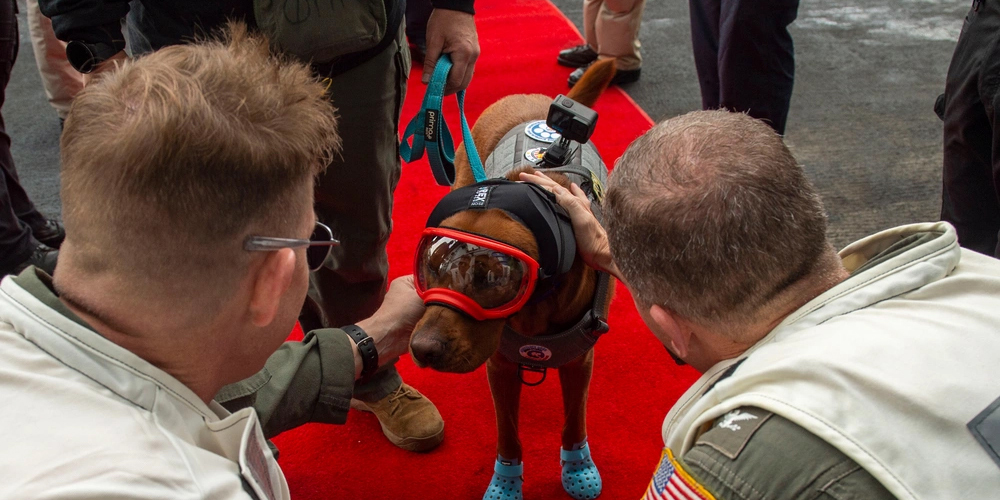 In December 2024, Rear Adm. Michael Wosje, left, commander of Carrier Strike Group One, and Capt. Matthew Thomas, commanding officer of USS Carl Vinson (CVN 70), welcome aboard Rudder, an NNS-sponsored expeditionary facility dog. U.S. Navy photo
In December 2024, Rear Adm. Michael Wosje, left, commander of Carrier Strike Group One, and Capt. Matthew Thomas, commanding officer of USS Carl Vinson (CVN 70), welcome aboard Rudder, an NNS-sponsored expeditionary facility dog. U.S. Navy photo NNS Sponsors an Extra ‘Rudder’ for USS Carl Vinson (CVN 70)
Published February 19, 2025
About two months ago in the Philippine Sea, a new captain arrived by helicopter onboard USS Carl Vinson (CVN 70) and immediately became a crew favorite.
Not only is this captain sponsored by Newport News Shipbuilding, he comes with four paws and a wagging tail.
Meet Rudder, an expeditionary facility dog (EFD), specially trained to thrive in the high-stress world of an aircraft carrier at sea. The dog’s presence on CVN 70 means more than occasional cuddles. Rudder assists in the mental health care of sailors, sensing when a crew member is experiencing anxiety or is under pressure.
A distinctive Red Fox Labrador Retriever, the dog really does carry the rank of captain.
Virginia Beach-based Mutts with a Mission spearheaded the Navy’s EFD initiative in 2023, training dogs like Rudder to provide mental health support to deployed sailors.
How Rudder came to be sponsored by NNS is another story.
Brook Colombo, who trains service dogs for the organization, was initially introduced to Rudder while visiting USS George Washington (CVN 73) during its Refueling and Complex Overhaul (RCOH). At the time, Rudder was only 8 weeks old and commencing his two-year training program with Mutts with a Mission.
Brook’s husband is Mark Colombo, director of Government Customer Relations at NNS. As Brook began to train the dog, Mark realized how the initiative might be something the company would be interested in supporting.
Mutts with a Mission accepts sponsorships for its dogs. Mark thought a company sponsorship would be a unique way to give back to the Navy and its sailors. He pitched the idea to Chip Miller, vice president of Customer Affairs, who readily agreed.
Ever since then, Rudder has been recognized as an NNS-sponsored service dog, sporting a company patch on his vest.
Rudder is the first EFD to deploy to a West Coast carrier. Other dogs have served aboard USS Gerald R. Ford (CVN 78) and USS Dwight D. Eisenhower (CVN 69), as well as USS Wasp (LHD 1), a multipurpose amphibious assault ship.
The dog’s gentle and welcoming nature can be key when a sailor needs someone to talk to, Brook said.
“They are a conduit to get the conversation started,” she said. “Sailors start to pet the dog and can talk about being away from home for the first time or whatever is on their minds. On the ship’s plan of the day, there is a paw print that marks where Rudder will be in case he’s needed.”
Before touching down on CVN 70, Rudder helped promote NNS, appearing at the Sea-Air-Space maritime exposition and the annual Tailhook symposium.
“People will ask about the NNS patch, and that’s resulted in a lot of attention,” Mark said.
Training a dog takes patience and time. Brook is currently training Radar, a black Lab whose future duty is not yet determined. Besides putting dogs on ships at sea, Mutts with a Mission provides dogs to various facilities, including police stations, and to individuals, such as veterans dealing with post-traumatic stress disorder or other disabilities.
The dogs are either Labs or Swiss mountain dogs, a larger breed. They can pull wheelchairs, provide a brace to help someone stand or quietly sit in a waiting room. Brook exposes dogs to stimuli that most people take for granted, taking them on an escalator at a shopping mall, or bringing them to a noisy basketball game, for example.
“Everything is a training opportunity,” she said.
A story describing Rudder’s arrival aboard CVN 70 was published in December on the Defense Visual Information Network. It was clear the dog was a big hit.
“I screamed,” said Rocio Zavala, a mass communication specialist seaman apprentice. “I was just so happy.”
“When he arrived and put all four paws on the deck, there was an immediate sense of joy and relief, like an early Christmas present,” said Capt. Ryan Mattson, the ship’s executive officer. “I knew the impact he was going to have on the crew.”
“I know Capt. Rudder is going to be busy,” said seaman recruit Augustus Sipp. “This is a carrier, after all. He’s always going to have something to do.”